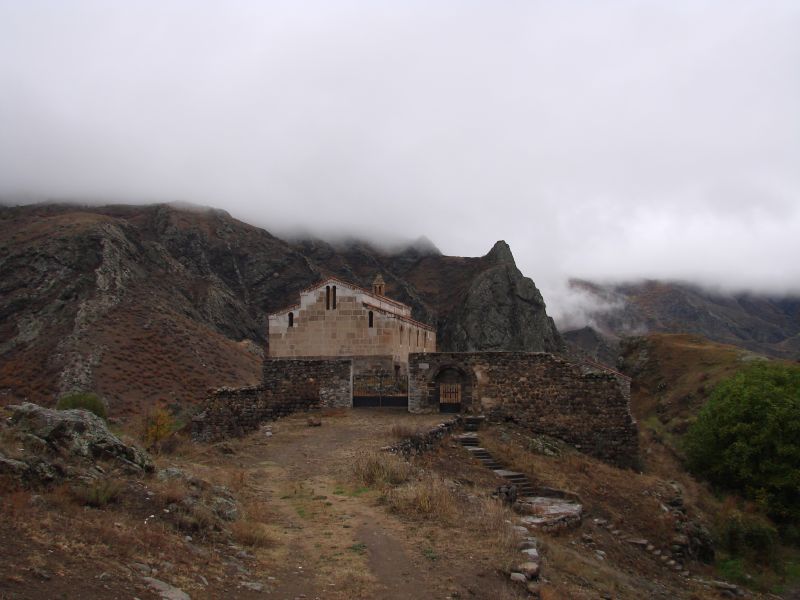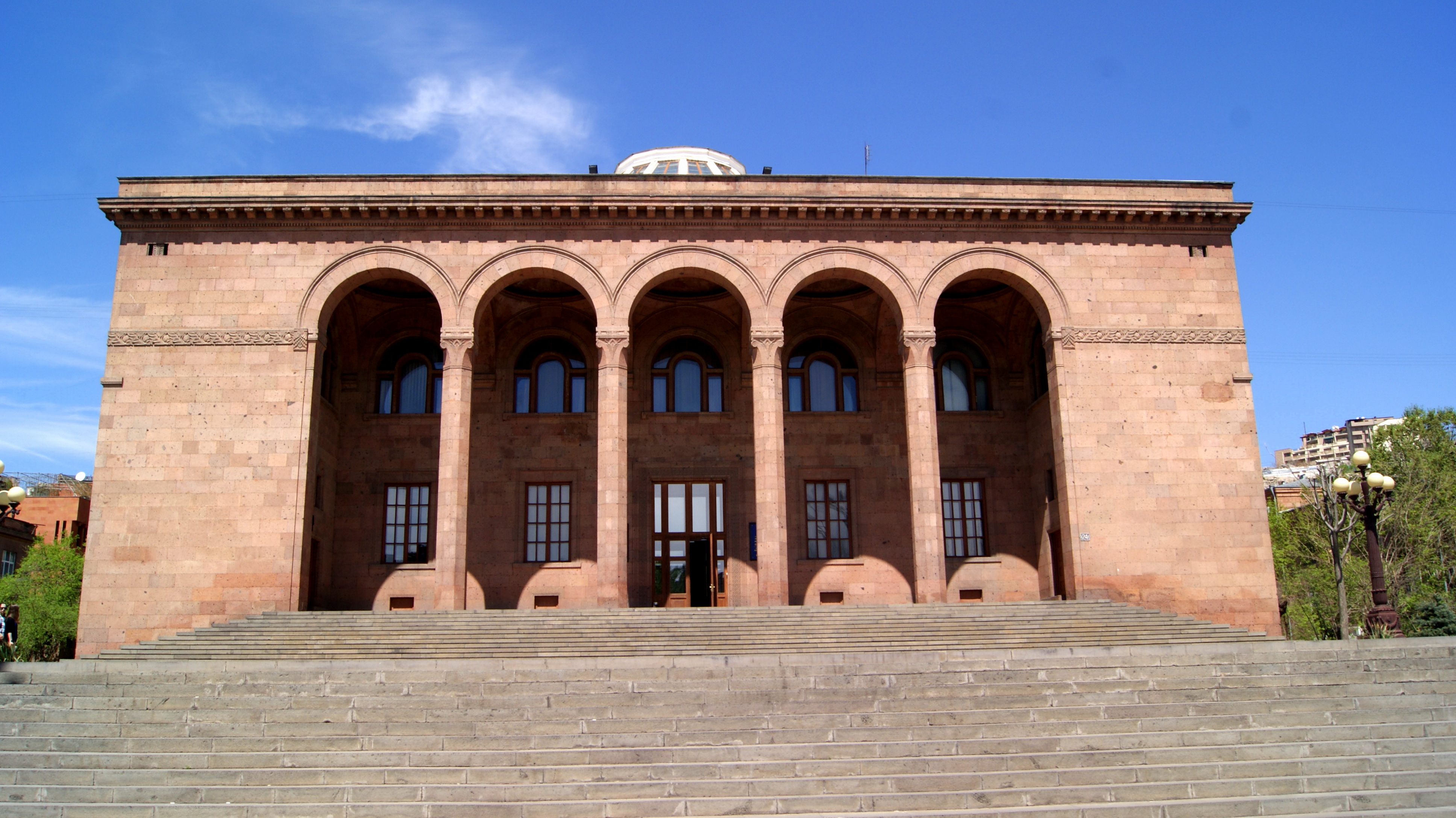|
Tzitzernavank Monastery
Tsitsernavank ( hy, Ծիծեռնավանք) is a fifth-to-sixth century Armenian Apostolic monastery in the Lachin District of Azerbaijan. The monastery is within five kilometers of the border of Armenia's province of Syunik, in an area historically known as ''Kashataghk'' (). In Azerbaijan, the monastery is called Aghoghlan (); the state refuses to recognize the monastery as Armenian Apostolic, instead referring to it as " Caucasian Albanian". Etymology There are two interpretations about the Armenian etymology of the church. The first interpretation is that the name of the church is based on Armenian word " Tsitsernak", which means swallow. According to researchers, the usage of this name of because of swallows who made nests in the church's ruins. According to the other interpretation, the name of the church is based on Armenian word " tsitsern", which means pinky finger, presumably a reference to the relics of St. George that were kept in the church. The etymology of the ... [...More Info...] [...Related Items...] OR: [Wikipedia] [Google] [Baidu] |
Hüsülü, Lachin
Husulu (), historically also known as Kashataghk () is a village in the Lachin District of Azerbaijan, located close to the villages of Malıbəy (Melikashen), Qarıqışlaq (Tandzut) and Ağoğlan. Armenian monuments such as the Tsitsernavank Monastery from between the 5th and 7th centuries, and the 15th-century Melik Haykaz Palace are located near the village. History Most Armenian historians identify the village with Kashataghk, a settlement mentioned by the 13th-century Armenian historian Stephen Orbelian (one Armenian historian, Armen Gharagyozian, instead identifies Kashataghk with the nearby village of Qarıqışlaq). Despite the village's small size and population, the whole region of Kashatagh was named after this settlement due to it being a princely residence of the Armenian Meliks of Kashatagh. The Kurdish population that settled in the Kashatagh region after the deportation of the Armenian population from the region by Shah Abbas I referred to the village as ... [...More Info...] [...Related Items...] OR: [Wikipedia] [Google] [Baidu] |
Armenian National Academy Of Sciences
The National Academy of Sciences of the Republic of Armenia (NAS RA) ( hy, Հայաստանի Հանրապետության գիտությունների ազգային ակադեմիա, ՀՀ ԳԱԱ, ''Hayastani Hanrapetut’yan gitut’yunneri azgayin akademia'') is the Armenian national academy, functioning as the primary body that conducts research and coordinates activities in the fields of science and social sciences in Armenia. It is a member of the International Science Council. History The Academy of Sciences of the Armenian Soviet Socialist Republic was founded on 10 November 1943, on the basis of the Armenian Branch of the Soviet Academy of Sciences, which was established almost 10 years earlier, in 1935. Among its founders were Joseph Orbeli, Stepan Malkhasyants, Ivan Gevorkian and Victor Ambartsumian; Orbeli became the first president of the academy. Presidents *Joseph Orbeli (1943–1947) *Victor Ambartsumian (1947–1993) *Fadey Sargsyan (1993–2006) * Radik Martiro ... [...More Info...] [...Related Items...] OR: [Wikipedia] [Google] [Baidu] |
Jean-Michel Thierry
Jean-Michel Thierry de Crussol (1916–2011) was a French physician and art historian. His specialities are in Byzantine art, Byzantine and Armenian art. He was born on 13 August 1916 in Bagnères de Luchon, France. He studied and got his education in Paris. He co-wrote the book ''Armenian Art'' in 1989 and also wrote many articles concerning Armenian art, especially Armenian architecture. Works * * * * Eglises et couvents du Karabagh * Monuments arméniens du Vaspurakan * Les Arts arméniens * Le Couvent arménien d'Horomos * La Cathédrale des Saints-Apôtres de Kars, 930-943 References External links *Jean-Michel Thierryon ACAM's biographies of authors * on Bibliomonde biographies of authors 1916 births 2011 deaths French art historians Armenian studies scholars French Byzantinists 20th-century French physicians People from Haute-Garonne French male non-fiction writers {{France-art-historian-stub ... [...More Info...] [...Related Items...] OR: [Wikipedia] [Google] [Baidu] |
Apse
In architecture, an apse (plural apses; from Latin 'arch, vault' from Ancient Greek 'arch'; sometimes written apsis, plural apsides) is a semicircular recess covered with a hemispherical vault or semi-dome, also known as an ''exedra''. In Byzantine, Romanesque, and Gothic Christian church (including cathedral and abbey) architecture, the term is applied to a semi-circular or polygonal termination of the main building at the liturgical east end (where the altar is), regardless of the shape of the roof, which may be flat, sloping, domed, or hemispherical. Smaller apses are found elsewhere, especially in shrines. Definition An apse is a semicircular recess, often covered with a hemispherical vault. Commonly, the apse of a church, cathedral or basilica is the semicircular or polygonal termination to the choir or sanctuary, or sometimes at the end of an aisle. Smaller apses are sometimes built in other parts of the church, especially for reliquaries or shrines of saints. Hi ... [...More Info...] [...Related Items...] OR: [Wikipedia] [Google] [Baidu] |
2020 Nagorno-Karabakh Ceasefire Agreement
The 2020 Nagorno-Karabakh ceasefire agreement is an armistice agreement that ended the Second Nagorno-Karabakh War. It was signed on 9November by the President of Azerbaijan Ilham Aliyev, the Prime Minister of Armenia Nikol Pashinyan and the President of Russia Vladimir Putin, and ended all hostilities in the Nagorno-Karabakh region from 00:00, 10 November 2020 Moscow time. The president of the self-declared Republic of Artsakh, Arayik Harutyunyan, also agreed to an end of hostilities. Background Renewed hostilities between Azerbaijan and Artsakh together with Armenia began on 27 September 2020. Azerbaijan recovered many of its territories during the following six weeks which culminated in the capture of the strategically important town Shusha and prompted the two sides to agree to a ceasefire deal on 9November 2020. Overview According to the agreement, both belligerent parties agreed to exchange prisoners of war and the dead. The Armenian forces were to withdraw from Armeni ... [...More Info...] [...Related Items...] OR: [Wikipedia] [Google] [Baidu] |
Armenian Diaspora
The Armenian diaspora refers to the communities of Armenians outside Armenia and other locations where Armenians are considered an indigenous population. Since antiquity, Armenians have established communities in many regions throughout the world. However, the modern Armenian diaspora was largely formed as a result of World War I, when the Armenian genocide committed by the Ottoman Empire forced Armenians living in their homeland to flee or risk being killed. Another wave of emigration started with the dissolution of the Soviet Union. Terminology In Armenian, the diaspora is referred to as spyurk (), spelled սփիւռք in classical orthography and սփյուռք in reformed orthography. In the past, the word gaghut ( գաղութ ) was used mostly to refer to the Armenian communities outside the Armenian homeland. It is borrowed from the Aramaic (Classical Syriac) cognate of Hebrew ''galut'' (גלות). History The Armenian diaspora has been present for over 1,700 years. The ... [...More Info...] [...Related Items...] OR: [Wikipedia] [Google] [Baidu] |
First Nagorno-Karabakh War
The First Nagorno-Karabakh War, referred to in Armenia as the Artsakh Liberation War ( hy, Արցախյան ազատամարտ, Artsakhyan azatamart) was an ethnic and territorial conflict that took place from February 1988 to May 1994, in the enclave of Nagorno-Karabakh in southwestern Azerbaijan, between the majority ethnic Armenians of Nagorno-Karabakh backed by Armenia, and the Republic of Azerbaijan. As the war progressed, Armenia and Azerbaijan, both former Soviet Republics, entangled themselves in protracted, undeclared mountain warfare in the mountainous heights of Karabakh as Azerbaijan attempted to curb the secessionist movement in Nagorno-Karabakh. The enclave's parliament had voted in favor of uniting with Armenia and a referendum, boycotted by the Azerbaijani population of Nagorno-Karabakh, was held, in which a majority voted in favor of independence. The demand to unify with Armenia began in a relatively peaceful manner in 1988; in the following months, as the S ... [...More Info...] [...Related Items...] OR: [Wikipedia] [Google] [Baidu] |
Stepanos Orbelian
Stepanos Orbelian ( hy, Ստեփանոս Օրբելեան, originally spelled hy, Ստեփաննոս, translit=Stepʻannos, label=none; – 1303) was a thirteenth-century Armenians, Armenian historian and the metropolitan bishop of the province of Syunik (historical province), Syunik. He is known for writing his well-researched ''History of the Province of Syunik''. Biography Stepanos Orbelian was a member of the Orbelian Dynasty, Orbelian princely family which ruled Armenia's Syunik (historical province), province of Syunik. The exact year of his birth is unknown, but he is thought to have been born sometime between 1250 and 1260. He received an excellent clerical education and was ordained as a celibate priest in 1280/81. In 1285/6, Stepanos's father Tarsayich Orbelian became the prince of Syunik and sent him to the Armenian Kingdom of Cilicia, where he was hosted at the court of King Leo III of Armenia, Levon III for three months. He was consecrated metropolitan bishop of ... [...More Info...] [...Related Items...] OR: [Wikipedia] [Google] [Baidu] |
Tatev
The Tatev Monastery ( hy, Տաթևի վանք, Tat'evi vank') is a 9th-century Armenian Apostolic monastery located on a large basalt plateau near the village of Tatev in the Syunik Province in southeastern Armenia. The term "Tatev" usually refers to the monastery. The monastic ensemble stands on the edge of a deep gorge of the Vorotan River. Tatev is known as the bishopric seat of Syunik and played a significant role in the history of the region as a center of economic, political, spiritual and cultural activity. The Monastery of Tatev has been described as one of the two best-known monasteries in Armenia, along with Noravank in the province of Vayots Dzor. In the 14th and 15th centuries, the monastery hosted one of the most important Armenian medieval universities, the University of Tatev, which contributed to the advancement of science, religion and philosophy, reproduction of books and development of miniature painting. Scholars of the Tatev University contributed to the pre ... [...More Info...] [...Related Items...] OR: [Wikipedia] [Google] [Baidu] |
Saint George
Saint George (Greek: Γεώργιος (Geórgios), Latin: Georgius, Arabic: القديس جرجس; died 23 April 303), also George of Lydda, was a Christian who is venerated as a saint in Christianity. According to tradition he was a soldier in the Roman army. Saint George was a soldier of Cappadocian Greek origin and member of the Praetorian Guard for Roman emperor Diocletian, who was sentenced to death for refusing to recant his Christian faith. He became one of the most venerated saints and megalomartyrs in Christianity, and he has been especially venerated as a military saint since the Crusades. He is respected by Christians, Druze, as well as some Muslims as a martyr of monotheistic faith. In hagiography, as one of the Fourteen Holy Helpers and one of the most prominent military saints, he is immortalized in the legend of Saint George and the Dragon. His memorial, Saint George's Day, is traditionally celebrated on 23 April. Historically, the countries of England, Ukrai ... [...More Info...] [...Related Items...] OR: [Wikipedia] [Google] [Baidu] |
Syunik (historic Province)
Syunik ( hy, Սիւնիք, translit=Siwnik') was a region of historical Armenia and the ninth province (') of the Kingdom of Armenia from 189 BC until 428 AD. From the 7th to 9th centuries, it fell under Arab control. In 821, it formed two Armenian principalities: Kingdom of Syunik and principality of Khachen, which around the year 1000 was proclaimed the Kingdom of Artsakh, becoming one of the last medieval eastern Armenian kingdoms and principalities to maintain its autonomy following the Turkic invasions of the 11th to 14th centuries.Hewsen. ''Armenia'', pp. 118-121. Name The name Syunik is ancient and appears in the earliest Armenian written sources. ', a later name for the province of Iranian origin, first appears in the 6th-century Syriac chronicle of Pseudo-Zacharias; it is first mentioned in Armenian sources in the history of Movses Khorenatsi, who explains this name as deriving from Sisak, the name of one of the descendants of the legendary Armenian progenitor Hayk ... [...More Info...] [...Related Items...] OR: [Wikipedia] [Google] [Baidu] |




